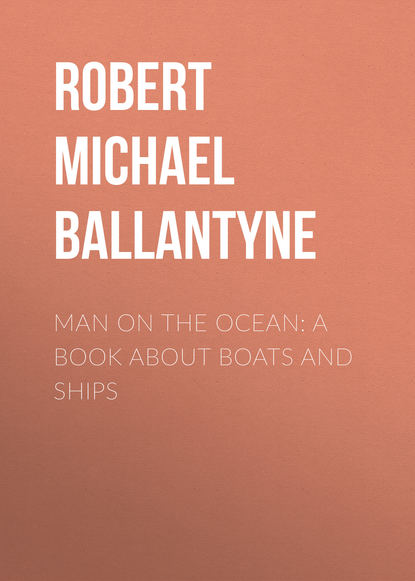 Полная версия
Полная версияMan on the Ocean: A Book about Boats and Ships
On the deck of a junk is always to be found a josshouse or temple, in front of which the crew keep incense, sticks, and perfumed paper continually burning. When a calm overtakes an English vessel, the sailors and passengers are always supposed to try what “whistling for a wind” will effect. In lieu of this method of “raising the wind,” a Chinese sailor shapes little junks out of paper, and sets them afloat on the water as a propitiatory service to the divinity who has the welfare of seamen under his especial care.
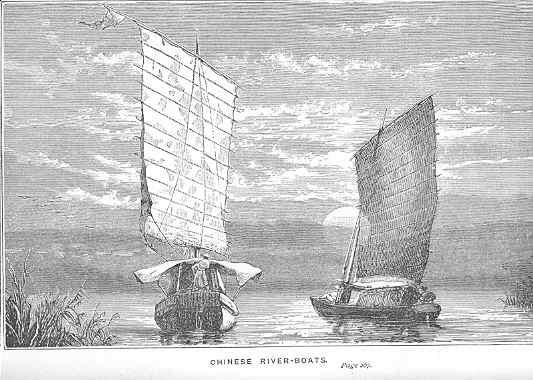
The river-life of China is very curious. Quite a large proportion of the people spend their whole lives on the water, while many who are employed during the day on land sleep in boats on the various rivers. This condition of things corresponds in some degree to that described by Captain Marryat in that fine old story “Jacob Faithful,” in the early chapters of which we get diverting glimpses of life on board a Thames lighterman. But the river population of China is still more absolutely aquatic in manner of life than the Thames barge-folk. The boats in which this class of the population live have an awning of bamboo and matting fore and aft, which is removed by day and raised at night. At sundown the boat-people anchor their craft in rows to stakes, thus forming boat-terraces as it were. When business grows slack at one part of the river, the master of the boat moves up or down stream to some other part. From the shape of these boats, resembling somewhat the half of an egg cut lengthwise, they are called in the Chinese language “egg-boats.” A large family will sometimes pack itself into an egg-boat not much more than twelve feet long and six broad.
These river-folk have characteristics which almost render them a people apart. They have a code of laws of their own, differing in many points from that which governs the land community, and the two populations do not intermarry. Women to a large extent navigate the egg-boats, as indeed they do many other kinds of boats in China. Travellers report that these river-families live peaceable and happy enough lives, seldom disturbed by disputes of any kind. Possibly one cause for this may be that which some humourist suggested as the reason why “birds in their little nests agree,” namely, because it would be dangerous if they “fell out.” But, speaking seriously, it says much for the placable nature of these Chinese river-folk that they can pass such a happy existence within the narrow bounds of their egg-boats.
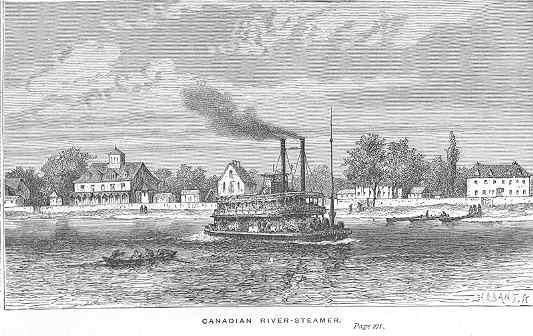
Passing over to America, we shall first describe the famous American and Canadian river steamboats, which are in many respects as curious and unique as they are generally magnificent. These steamers are usually paddle-boats; are very long and narrow in shape, but of great strength. On the hull a sort of lofty platform is built, which is divided into what may be called the middle and the main deck, one above the other. Fore and aft there is a spacious, luxuriously appointed, and richly decorated saloon, covered in with a glass roof.
Ranged on each side of the saloon are the cabins, each containing two berths. These sleeping-cabins, like the saloon, are prettily furnished and tastefully decorated. Over the saloon is another deck or platform—the whole structure as may be seen from our illustration is very much “be-decked”—about the middle of the vessel and in front of the funnel. Here is situated the wheel, and here also the captain and officers take their position. This part of the vessel is kept private to them, no passenger being permitted to trespass on it.
Beneath the saloon-deck is the middle-deck, as has already been indicated, which also contains a saloon of its own, as well as sleeping apartments. This portion of the steamer is usually reserved for the unmarried ladies among the passengers, who, as all readers of American literature must be aware, are treated in America with an almost chivalrous courtesy and consideration.
The dining-saloon of the vessel is situated in a third and undermost deck, which reaches from the middle of the boat right aft, and is a well-lighted, well-arranged room.
The cargo is placed amidships, heaped up in great piles—passenger boats seldom or never carrying heavy goods. The American’s passion for economising time is manifest in the steamboats as everywhere else, most of them carrying a barber, who will accommodate you with “easy shaving” during the voyage. The barber’s shop is forward with the cook’s quarters and other offices. American river-boats may vary, of course, in details, but we have endeavoured to indicate the leading characteristics of a typical example. The stories current in regard to the facility with which an American steamboat blows up have been much exaggerated, but nevertheless it is probably true that they bear the bell in this direction of risk and danger.
Of all craft of the canoe order, the flying-proa of the Pacific is the swiftest. It carries a sail almost triangular in shape, and a straight yard. It has an outrigger; and outrigger, mast, and yard are of bamboo. Strong matting composes the sail, which is stretched very flat upon the yard. When the crew wish to put their boat about they have merely to shift the sail, when what was before the prow of the proa becomes the stern. These boats are usually manned by a crew of about half-a-dozen. One man sits at either end of the vessel and takes his turn of steering according to whatever tack the canoe is on. The duty of the rest is to bail out the boat and to keep the sail properly trimmed.
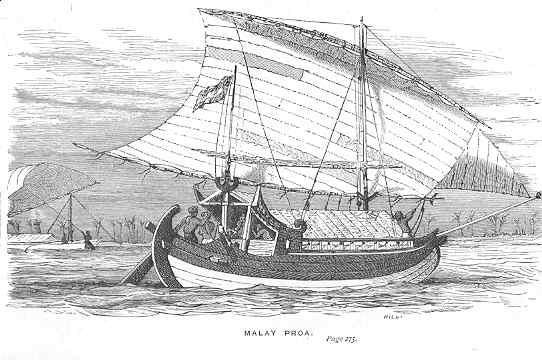
Nothing afloat, probably, can go so close to the wind as the flying-proa, while its speed is astonishing. The Malays use the proa, but theirs is a broader, heavier, and less swift boat than that used by the Ladrone islanders of the Pacific, which is that which we have just described.
The canoes of the Fijians are superior to those in use among any other of the South Sea islanders. Their chief feature is that they are twin-canoes, joined together by cross-beams, which support a platform of from twelve to fifteen feet broad. Of the two canoes, one is smaller than the other, and the smaller serves by way of an outrigger. These canoes are sometimes one hundred feet long, their depth being usually about seven feet. Sometimes a small cabin is built upon the platform. The mast is about thirty feet long, is supported by guys, and is furnished with a yard carrying a large sail. There are small hatchways at both ends of the craft, at each of which one of the crew sits ready to bail out the boat. The Fijian canoes can also be propelled by means of sculling, the sculler using a broad-bladed scull about ten feet in length. A large canoe can be got through the water at the rate of two or three miles an hour by sculling.
Various experiments have from time to time been made in the way of building boats and ships with double hulls, the object being to obtain increased stability, and thus reduce to a minimum the rolling and pitching of ordinary vessels. The steamship Castalia was an ambitious attempt in this direction. She was built for the passenger service between England and France. But she did not realise the expectations formed of her.
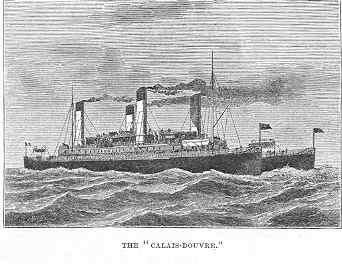
Most persons who have crossed from Dover to Calais, or vice versa, by the Calais-Douvre mail packet, will bear witness both to the comfort and speed of that vessel. Up to this she has proved the most perfect form of steam-ship yet constructed for the purpose required. The Calais-Douvre is built somewhat upon the same principle as the Castalia, but differs from that vessel in that whereas the latter was two half-ships joined together, each twin-portion of the Calais-Douvre is a perfect ship in itself. The result has been, that while the Castalia was a failure, the Calais-Douvre has proved a distinct success. She is three hundred feet in length and sixty feet in breadth; her tonnage is two thousand, and her water-draught only six feet, so that she can enter Calais Harbour at even a low tide. Two transverse iron girder bulk-heads unite the two hulls of the vessel; and her steering apparatus is so simple, and at the same time so effective in construction, that one wheel is usually sufficient to work it. She makes the passage from Dover to Calais usually in an hour and a half; but in very fine weather we ourselves have crossed in less than that time. With the maximum rate of speed, the Calais-Douvre has attained the minimum amount of pitching and rolling yet secured by any Channel boat. Her saloons, cabins, and decks are spacious and handsomely appointed, so that the Channel passage in this vessel is made under as favourable conditions for bad sailors as any sea-passage can be.



